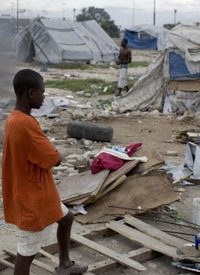
Some $12 billion was pledged, including $2.75 billion from the United States, $650 million from the European Union, and the balance from 35 other countries.
Much of the U.S. government’s aid was funneled through the U.S. Agency for International Development (USAID), which reported that it helped build a 10-megawatt power plant and repaired and upgraded five electric power substations in Port-au-Prince, provided some $10 million in financing for 46 “micro financial institutions and financial cooperatives” and another 7,600 loans to coffee, cocoa, and mango growers. USAID rebuilt roads, irrigation systems, and storage and processing facilities, while offering “improved seeds, fertilizer and technologies to more than 9,700 farmers [who] have increased rice yields by 64 percent, corn yields by 338 percent, bean crops by 97 percent, and plantain outputs by 21 percent for beneficiary farmers.”
According to the USAID report, the agency built 600 semi-permanent furnished classrooms, which allowed some 60,000 students to return to school after the earthquake. It also helped build a temporary Parliament building to replace the one destroyed by the earthquake.
So far, so good. But when the Government Accounting Office (GAO) looked at the progress made by the Interim Haiti Recovery Commission (IHRC), a joint effort between the Haitian authorities and international donors to coordinate the flow of assistance last May, the GAO was chagrined to find that little had been done in the field. Most of the energy and funds had been expended in planning, organizing, and “getting ready to get ready.” Said the GAO,
Although the commission’s mandate end[ed] in October 2011, [the] IHRC is not fully operational due to delays in staffing the commission and defining the role of its Performance and Anticorruption Office.… [As a result the] IHRC’s ability to direct funding to Haitian priorities is limited, in part because those priorities have not been clear.
As a result, funding for approved projects is uneven across sectors and not necessarily aligned with Haitian priorities….
IHRC has recently developed a strategic plan to begin to help clarify Haitian priorities.
In other words, bureaucracy has fumbled the ball, and funds remain in escrow somewhere but are not likely to get to the hapless citizens of Haiti who need it the most any time soon.
Marc Cohen, a senior researcher for Oxfam, an international confederation of 15 non-government organizations (NGOs) around the world, blasted efforts at rebuilding Haiti that still leave half a million Haitians homeless two years after the quake. By the end of last September, less than half the money pledged from countries around the world had been received. And much of those funds remain tied up in committee.
A great deal of the money promised by the U.S. government has been used to pay back the government for aid given to Haiti following the quake. According to the GAO, of the original $1.4 billion allocated by Congress, $655 million was “reimbursed” back to the Department of Defense for its expenses involved in bringing in food and medical aid and for providing the 20,000 troops to secure the airport.
Another $220 million went to repay the U.S. Department of Health and Human Services for its costs in providing goods, food, and grants to Haitian refugees for food and shelter. An additional $350 million went to “disaster assistance,” $150 million to the U.S. Department of Agriculture, and $15 million to the Department of Homeland Security for “immigration fees and aircraft fares” for those few Haitians lucky enough to find their way to the United States.
It gets worse. The UN Special Envoy for Haiti reported that $864 million of the $2.4 billion pledged was given back to the donors while $672 million went to the United Nations.
Robert Fatton, a professor of government and foreign affairs at the University of Virginia, was outraged: “In the end, if you read the reports — the UN report and so on — you’ll see that actual Haitians got less than 1 percent of all the American money pledged. 99 percent went back to the US military, the State Department, NGOs and contractors. The money was clearly intended for Haiti, but it ended up returning to the same place it came from.”
The local Toyota dealership in Port-au-Prince is doing very nicely, however. When Donovan Webster, a writer for Salon magazine, stopped in to see how business was doing, he found “a modern and well-tended building on the city’s airport road (with mirrored-glass windows from floor to ceiling and a perfectly buffed showroom floor).” In a conversation with a saleslady who preferred to remain anonymous, Webster learned that sales of Toyota Land Cruisers — the vehicle of choice for many NGOs — were excellent. Webster asked: “Who’s buying them?”
Saleslady: I’d say that, for us, 95 percent go to the NGOs, [and] some go to rental agencies which then rent them out to the NGOs.
Webster: How much does each Land Cruiser cost?
Saleslady: Each one, with taxes, is $61,100. If you have tax-free status, you can get them for less but then you have to take them with you or give them away. If you pay the taxes, you can just sell the car.
Webster: And how many do you sell?
Saleslady: This year we sold 250 of this model. But, you know, right after the earthquake, for several months, we were probably selling that many Land Cruisers every month. Maybe twice that many.
Webster did the math and concluded that at least $100 million of the unaccounted funds went to Toyota: “Maybe $150 million. And that’s a conservative estimate.”
There’s an old saying: “To err is human, but to really foul things up takes a computer.” The updated saying is from the Haitian experience: “To really foul things up takes a government bureaucracy with no accountability.”
Photo: AP Images



